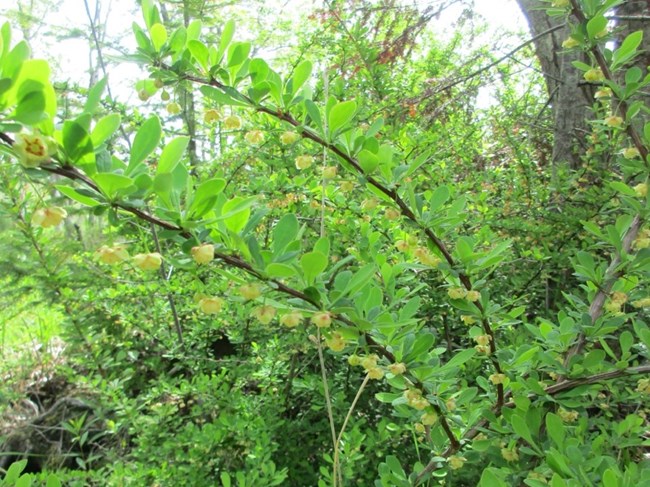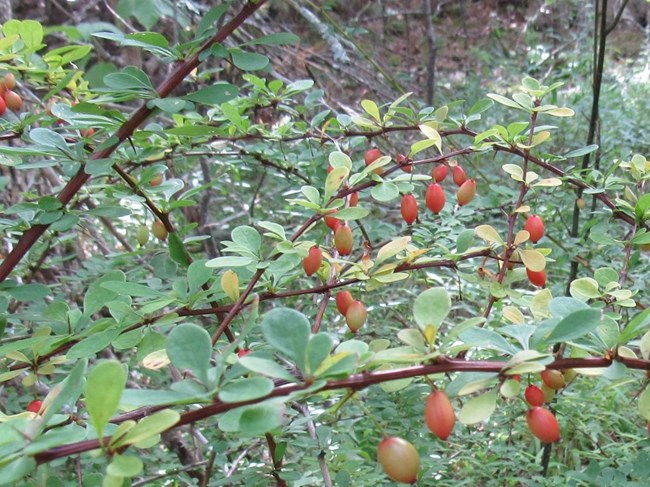Last updated: August 27, 2020
Article
Invasive Plant Profile: Japanese Barberry

NPS Photo/Sophia Cameron
By Sophia Cameron, Invasive Plant Management Intern and Jesse Wheeler, Vegetation Program Manager
Japanese Barberry
Japanese barberry (Berberis thunbergii) is a very unique looking shrub and often difficult to miss. They can grow as either a single, dense bush or as large thickets through close-range seed dispersal. They may also reach up to nearly five feet in height if given the proper soil and sunlight, creating a wall of dense thorns. These dense stands create an environment that is perfect for the black-legged tick, or deer tick (Ixodes scapularis), the vector for Lyme disease and other tick-borne illnesses. Long-term studies have shown that tick densities are higher in Japanese barberry than areas dominated by native shrubs and that removing barberry from the landscape can reduce tick numbers.
Emerging in early spring before many native plants, the leaves of Japanese barberry are oval-shaped, simple, and entire, and turn a bright orange color in the fall season before falling off. From May to early July it can be identified by its very small, white flowers that seem to hang off of the stems, facing downwards. These flowers can also sometimes appear pink or yellow. The shrubs reach reproductive age at two years, at which point they will start producing small, red to orange fruits in the late summer and fall. One of their most distinctive features is their single thorns, which are alternating and grow up the entirety of the stems.
These shrubs tend to prefer a large amount of sunlight, which makes old pastures and forest gaps ideal environments. Their soil pH range is much wider than other shrubs of similar sizes, so they are also very successful around roadways or areas of human disturbance. They are perennials, so although they drop their leaves to overwinter, they can survive almost indefinitely given the correct growing conditions.

NPS Photo/Sophia Cameron
How did it arrive here?
The first intentional introduction of Japanese barberry to North America is recorded to have occurred in 1875 when it was shipped from Russia to the Arnold Arboretum in Boston. It is suspected, however, that there were accidental introductions before this since the seeds of the shrub can remain dormant for up to two years. This would make it easy for seeds to be accidentally transported across the ocean.
Why is it invasive?
Both Japanese barberry and common barberry became very popular in American landscaping in the early 1900s into the 1970s because of their ability to form dense thickets which provided homes with increased privacy from busy roadways. Their fruits were also attractive to birds, such as turkey and grouse, that can disperse seed great distances and contribute to their success as an invasive species. The shrubs can also reproduce through rhizomes, or a particular kind of root system that can travel several feet away from the parent shrub to begin a new area of growth. This makes them particularly difficult to manage since cutting off the stems is not enough to kill the plant.
As mentioned before, these shrubs are also incredibly hardy. They can grow in virtually any soil type and need very little water. In Acadia, we have seen Japanese barberry doing quite well in habitats ranging from acidic bogs to hardwood forests. They can even adapt to grow without sufficient sunlight, but growth will explode as soon as it has full sun. All of this allows them to grow in a wide variety of areas, often making them difficult to locate. On top of all of this, their foliage is also toxic to deer, virtually eliminating the possibility of control via browse or defoliation by native wildlife. Because of this they often are kept unchecked and end up destroying large amounts of native habitats and out-competing native plant species.
Management at Acadia
Like with other invasive species, Japanese barberry is actively managed at Acadia National Park. The Invasive Plant Management Team (IPMT) searches for new stands of Japanese barberry by surveying suspected habitats and removes them either with mechanical or chemical control methods. One of the most common areas where Japanese barberry has been found is on old homestead and estate grounds, along stream corridors, as well as in new growth forests of mixed hardwood and conifer trees. Between 2018 and 2019, the IPMT removed barberry scattered over a combined 1,000 acres of forest and wetlands in Acadia. Luckily, Acadia is relatively well off, with light infestations of a handful of plants, opposed to acres of dense stands found elsewhere in New England. Staying vigilant and detecting populations early is the key to long-term success and health of Acadia’s forests.
Public Action
Those living near Acadia National Park are urged to avoid planting Japanese barberry in their gardens, as they are likely to spread to surrounding areas. Instead, plant native shrubs that can provide just as much privacy, and provide similar landscaping benefits. Removal and management of any existing Japanese barberry on private property is also encouraged. If you believe you have found Japanese barberry within the park you can report sightings to the IPMT with the contact information found below.
Contact Information
Jesse Wheeler
e-mail us
207-288-8722
References
“The Invasion Ecology of Japanese Barberry (Berberis Thunbergii) in the New England Landscape | SpringerLink.” n.d. Accessed July 23, 2020. https://link.springer.com/article/10.1023/A:1010024202294.
Ward, Jeffrey S., Thomas E. Worthley, and Scott C. Williams. 2009. “Controlling Japanese Barberry (Berberis Thunbergii DC) in Southern New England, USA.” Forest Ecology and Management 257 (2): 561–66. https://doi.org/10.1016/j.foreco.2008.09.032.
Scott C Williams, Megan A Linske, Jeffrey S Ward, Long-Term Effects of Berberis thunbergii (Ranunculales: Berberidaceae) Management on Ixodes scapularis (Acari: Ixodidae) Abundance and Borrelia burgdorferi (Spirochaetales: Spirochaetaceae) Prevalence in Connecticut, USA, Environmental Entomology, Volume 46, Issue 6, December 2017, Pages 1329–1338
Native Plant Trust. Framingham, MA. https://gobotany.nativeplanttrust.org/species/berberis/thunbergii/
